Mapping Seasonal High-Resolution PM2.5 Concentrations with Spatiotemporal Bagged-Tree Model across China
Abstract
:1. Introduction
2. Study Area and Datasets
2.1. Study Area
2.2. MODIS AOD
2.3. VIIRS IP AOD
2.4. Meteorological Data
2.5. Geographic and Topographic Data
3. Methodology
3.1. Multi-Source AOD Data Fusion
3.2. Spatiotemporal Bagged-Tree Model
3.2.1. Bagged-Tree Model
3.2.2. Spatiotemporal Weighted Function
3.3. Other Models
3.3.1. MLR Model
3.3.2. LME Model
3.4. Model Evaluation
4. Results and Discussion
4.1. Assessment of Fused AOD and Statistical Analysis of the Datasets
4.1.1. Assessment of Fused AOD
4.1.2. Statistical Analysis of the Datasets
4.2. Model Evaluation and Comparison
4.3. Spatial Distributions of Surface PM2.5 Levels
4.4. Regional PM2.5 Concentrations
5. Conclusions
- (1)
- Compared with the average coverage of the original MAIAC AOD (21.20%), the coverage of the fused AOD reaches 37.24% by using an adaptive threshold algorithm of auxiliary pixels.
- (2)
- Compared with traditional MLR (R2 = 0.38, MAE = 18.15 μg/m3, RMSE = 29.06 μg/m3) and LME (R2 = 0.52, MAE = 15.43 μg/m3, RMSE = 25.41 μg/m3) models, the STBT model can map regional PM2.5 concentrations with a higher R2 (0.84), lower MAE (8.77 μg/m3), and RMSE (15.14 μg/m3), based on sample-based 10-fold CV.
- (3)
- Seasonally spatial distributions of surface PM2.5 levels estimated by the STBT model display the significant seasonal changes. Among the seasons, summer reveals the lowest pollution levels, followed by spring and autumn. Winter shows the highest pollution levels. In terms of spatial distribution, the pollution in the Beijing–Tianjin–Hebei and Xinjiang regions is high while that in the southeast coastal region is low.
Author Contributions
Funding
Data Availability Statement
Conflicts of Interest
Nomenclature
| Acronym | Full Name |
| AERONET | Aerosol Robotic Network |
| AOD | Aerosol Optical Depth |
| BLH | Boundary Layer Height |
| CNEMC | China National Environmental Monitoring Center |
| CV | Cross Validation |
| LME | Linear Mixed-effect |
| MAE | Mean Absolute Error |
| MAIAC | Multiangle Implementation of Atmospheric Correction |
| MLR | Multiple Line Regression |
| MODIS | Moderate Resolution Imaging Spectroradiometer |
| NDVI | Normalized Difference Vegetation |
| R2 | Determinate Coefficient |
| RH | Relative Humidity |
| PM2.5 | Particulate Matter with Aerodynamic Diameter less than 2.5 μm |
| RMSE | Root Mean Square Error |
| STBT | Spatiotemporal bagged-tree |
| Temp | Temperature |
| USGS | United States Geological Survey |
| VIIRS | Visible Infrared Imaging Radiometer Suite |
| WS | Wind Speed |
References
- Jin, M.; Yang, H.W.; Tao, A.L.; Wei, J.F. Evolution of the protease-activated receptor family in vertebrates. Int. J. Mol. Med. 2016, 37, 593–602. [Google Scholar] [CrossRef] [PubMed] [Green Version]
- Di, Q.; Kloog, I.; Koutrakis, P.; Lyapustin, A.; Wang, Y.; Schwartz, J. Assessing PM2.5 Exposures with High Spatiotemporal Resolution across the Continental United States. Env. Sci. Technol. 2016, 50, 4712–4721. [Google Scholar] [CrossRef] [PubMed] [Green Version]
- Ailshire, J.; Karraker, A.; Clarke, P. Neighborhood social stressors, fine particulate matter air pollution, and cognitive function among older U.S. adults. Soc. Sci. Med. 2017, 172, 56–63. [Google Scholar] [CrossRef] [Green Version]
- Lee, M.; Schwartz, J.; Wang, Y.; Dominici, F.; Zanobetti, A. Long-term effect of fine particulate matter on hospitalization with dementia. Environ. Pollut. 2019, 254, 112926. [Google Scholar] [CrossRef]
- Chen, H.; Kwong, J.C.; Copes, R.; Tu, K.; Villeneuve, P.J.; van Donkelaar, A.; Hystad, P.; Martin, R.V.; Murray, B.J.; Jessiman, B.; et al. Living near major roads and the incidence of dementia, Parkinson’s disease, and multiple sclerosis: A population-based cohort study. Lancet 2017, 389, 718–726. [Google Scholar] [CrossRef]
- Di, Q.; Amini, H.; Shi, L.; Kloog, I.; Silvern, R.; Kelly, J.; Sabath, M.B.; Choirat, C.; Koutrakis, P.; Lyapustin, A.; et al. An ensemble-based model of PM2.5 concentration across the contiguous United States with high spatiotemporal resolution. Environ. Int. 2019, 130, 104909. [Google Scholar] [CrossRef]
- Huang, K.; Xiao, Q.; Meng, X.; Geng, G.; Wang, Y.; Lyapustin, A.; Gu, D.; Liu, Y. Predicting monthly high-resolution PM2.5 concentrations with random forest model in the North China Plain. Env. Pollut. 2018, 242, 675–683. [Google Scholar] [CrossRef]
- Dubovik, O.; Smirnov, A.; Holben, B.N.; King, M.D.; Kaufman, Y.J.; Eck, T.F.; Slutsker, I. Accuracy assessments of aerosol optical properties retrieved from Aerosol Robotic Network (AERONET) Sun and sky radiance measurements. J. Geophys. Res. Atmos. 2000, 105, 9791–9806. [Google Scholar] [CrossRef] [Green Version]
- Chatterjee, A.; Michalak, A.M.; Kahn, R.A.; Paradise, S.R.; Braverman, A.J.; Miller, C.E. A geostatistical data fusion technique for merging remote sensing and ground-based observations of aerosol optical thickness. J. Geophys. Res. Space Phys. 2010, 115, 115. [Google Scholar] [CrossRef] [Green Version]
- Guo, J.-P.; Zhang, X.-Y.; Che, H.-Z.; Gong, S.-L.; An, X.; Cao, C.-X.; Guang, J.; Zhang, H.; Wang, Y.-Q.; Zhang, X.-C.; et al. Correlation between PM concentrations and aerosol optical depth in eastern China. Atmos. Environ. 2009, 43, 5876–5886. [Google Scholar] [CrossRef]
- Engel-Cox, J.A.; Holloman, C.H.; Coutant, B.W.; Hoff, R.M. Qualitative and quantitative evaluation of MODIS satellite sensor data for regional and urban scale air quality. Atmos. Environ. 2004, 38, 2495–2509. [Google Scholar] [CrossRef]
- Xie, Y.; Wang, Y.; Zhang, K.; Dong, W.; Lv, B.; Bai, Y. Daily Estimation of Ground-Level PM2.5 Concentrations over Beijing Using 3 km Resolution MODIS AOD. Env. Sci Technol. 2015, 49, 12280–12288. [Google Scholar] [CrossRef] [Green Version]
- Wei, J.; Li, Z.; Huang, W.; Xue, W.; Song, Y. Improved 1-km-Resolution PM2.5 Estimates across China Using the Space-Time Extremely Randomized Trees. Atmos. Chem. Phys. Discuss. 2019. [Google Scholar] [CrossRef] [Green Version]
- Sun, T.M.; Chang, Y.H.; Chang, K.E.; Lin, T.H. Using radiance of cloud shadow for retrieve Investigation of AOD retrieval with Himawari-8 satellite data. In Proceedings of the Egu General Assembly Conference, Vienna, Austria, 17–22 April 2016. [Google Scholar]
- Wang, W.; He, J.; Miao, Z.; Du, L. Space–Time Linear Mixed-Effects (STLME) Model for Mapping Hourly Fine Particulate Loadings in the Beijing–Tianjin–Hebei Region, China. J. Clean. Prod. 2021, 292, 125993. [Google Scholar] [CrossRef]
- Lyapustin, A.; Wang, Y.; Korkin, S.; Huang, D. Collection 6 MAIAC algorithm. Atmos. Meas. Tech. 2018, 11, 5741–5765. [Google Scholar] [CrossRef] [Green Version]
- Lyapustin, A.; Wang, Y.; LaszloI, I.; Korkin, S. Improved cloud and snow screening in MAIAC aerosol retrievals using spectral and spatial analysis. Atmos. Meas. Tech. 2012, 5, 843–850. [Google Scholar] [CrossRef] [Green Version]
- Liu, H.; Remer, M.A.; Huang, J. Preliminary evaluation of S-NPP VIIRS aerosol optical thickness. J. Geophys. Res. Atmos. 2014, 119, 3942–3962. [Google Scholar] [CrossRef]
- Jackson, J.M.; Liu, H.; Laszlo, I.; Kondragunta, S.; Remer, L.A.; Huang, J.; Huang, H.C. Suomi-NPP VIIRS aerosol algorithms and data products. J. Geophys. Res. Atmos. 2013, 118, 12673–12689. [Google Scholar] [CrossRef]
- Zhang, Y.; Li, Z. Remote sensing of atmospheric fine particulate matter (PM2.5) mass concentration near the ground from satellite observation. Remote Sens. Environ. 2015, 160, 252–262. [Google Scholar] [CrossRef]
- Li, T.; Shen, H.; Yuan, Q.; Zhang, X.; Zhang, L. Estimating Ground-Level PM2.5 by Fusing Satellite and Station Observations: A Geo-Intelligent Deep Learning Approach. Geophys. Res. Lett. 2017. [Google Scholar] [CrossRef] [Green Version]
- Yu, W.; Liu, Y.; Ma, Z. Improving satellite-based PM2.5 estimates in China using Gaussian processes modeling in a Bayesian hierarchical setting. Sci. Rep. 2017, 7, 1–9. [Google Scholar] [CrossRef] [Green Version]
- Ma, Z.; Hu, X.; Huang, L.; Bi, J.; Liu, Y. Estimating Ground-Level PM2.5 in China Using Satellite Remote Sensing. Env. Sci. Technol. 2014, 48, 7436–7444. [Google Scholar] [CrossRef]
- Chen, G.; Li, S.; Knibbs, L.D.; Hamm, N.A.S.; Cao, W.; Li, T.; Guo, J.; Ren, H.; Abramson, M.J.; Guo, Y. A machine learning method to estimate PM2.5 concentrations across China with remote sensing, meteorological and land use information. Sci. Total Env. 2018, 636, 52–60. [Google Scholar] [CrossRef] [PubMed]
- Chen, Y.; Wu, S.; Wang, Y.; Zhang, F.; Du, Z. Satellite-Based Mapping of High-Resolution Ground-Level PM2.5 with VIIRS IP AOD in China through Spatially Neural Network Weighted Regression. Remote Sens. 2021, 13, 1979. [Google Scholar] [CrossRef]
- Mhawish, A.; Banerjee, T.; Sorek-Hamer, M.; Lyapustin, A.; Broday, D.M.; Chatfield, R. Comparison and evaluation of MODIS Multi-Angle Implementation of Atmospheric Correction (MAIAC) aerosol product over South Asia. Remote Sens. Environ. 2019, 224, 12–28. [Google Scholar] [CrossRef]
- Meng, F.; Cao, C.; Shao, X. Spatio-temporal variability of Suomi-NPP VIIRS-derived aerosol optical thickness over China in 2013. Remote Sens. Environ. 2015, 163, 61–69. [Google Scholar] [CrossRef]
- Yao, F.; Si, M.; Li, W.; Wu, J. A multidimensional comparison between MODIS and VIIRS AOD in estimating ground-level PM2.5 concentrations over a heavily polluted region in China. Sci. Total. Environ. 2018, 618, 819–828. [Google Scholar] [CrossRef] [PubMed]
- Karagiannidis, A.; Poupkou, A.; Giannaros, T.; Giannaros, C.; Melas, D.; Argiriou, A. The Air Quality of a Mediterranean Urban Environment Area and Its Relation to Major Meteorological Parameters. Water Air Soil Pollut. 2015, 226, 2239. [Google Scholar] [CrossRef]
- Zhang, T.; Chao, Z.; Wei, G.; Wang, L.; Zhu, Z. Improving spatial coverage for Aqua MODIS AOD using NDVI-based multi-temporal regression analysis. Remote Sens. 2017, 9, 340. [Google Scholar] [CrossRef] [Green Version]
- Yuan, W.A. Large-scale MODIS AOD products recovery: Spatial-temporal hybrid fusion considering aerosol variation mitigation. ISPRS J. Photogramm. Remote Sens. 2019, 157, 1–12. [Google Scholar]
- Wang, W.; Mao, F.; Pan, Z.; Du, L.; Gong, W. Validation of VIIRS AOD through a Comparison with a Sun Photometer and MODIS AODs over Wuhan. Remote Sens. 2017, 9. [Google Scholar] [CrossRef] [Green Version]
- Margineantu, D.D.; Dietterich, T.G. Improved Class Probability estimates from Decision Tree Models. Nonlinear Estim. Classif. 2003, 171, 173–188. [Google Scholar]
- Banfield, R.E.; Hall, L.O.; Bowyer, K.W.; Kegelmeyer, W.P. A comparison of decision tree ensemble creation techniques. IEEE Trans. pattern Anal. Mach. Intell. 2007, 29, 173–180. [Google Scholar] [CrossRef]
- Rodriguez, S.; Querol, X.; Alastuey, A.; Viana, M.-M.; Alarcón, M.; Mantilla, E.; Ruiz, C.R. Comparative PM10–PM2.5 source contribution study at rural, urban and industrial sites during PM episodes in Eastern Spain. Sci. Total Environ. 2004, 328, 95–113. [Google Scholar] [CrossRef]
- Zhang, Y.L.; Cao, F. Fine particulate matter (PM 2.5) in China at a city level. Sci Rep. 2015, 5, 14884. [Google Scholar] [CrossRef] [Green Version]
- Wang, W.; Mao, F.; Du, L.; Pan, Z.; Gong, W.; Fang, S. Deriving Hourly PM2.5 Concentrations from Himawari-8 AODs over Beijing–Tianjin–Hebei in China. Remote Sens. 2017, 9, 858. [Google Scholar] [CrossRef] [Green Version]
- Wang, W.; Mao, F.; Zou, B.; Guo, J.; Wu, L.; Pan, Z.; Zang, L. Two-stage model for estimating the spatiotemporal distribution of hourly PM1. 0 concentrations over central and east China. Sci. Total Environ. 2019, 675, 658–666. [Google Scholar] [CrossRef]
- Nava, S.; Prati, P.; Lucarelli, F.; Mandò, P.A.; Zucchiatti, A. Source Apportionment in the Town of La Spezia (Italy) by Continuous Aerosol Sampling and PIXE Analysis. Water Air Soil Pollut. Focus 2002, 2, 247–260. [Google Scholar] [CrossRef]
- Rushdi, A.I.; Al-Mutlaq, K.F.; Al-Otaibi, M.; El-Mubarak, A.H.; Simoneit, B.R.T. Air quality and elemental enrichment factors of aerosol particulate matter in Riyadh City, Saudi Arabia. Arab. J. Geosci. 2013, 6, 585–599. [Google Scholar] [CrossRef]
- Noble, C.A.; Mukerjee, S.; Gonzales, M.; Rodes, C.E.; Lawless, P.A.; Natarajan, S.; Myers, E.A.; Norris, G.A.; Smith, L.; Oezkaynak, H. Continuous measurement of fine and ultrafine particulate matter, criteria pollutants and meteorological conditions in urban El Paso, Texas. Atmos. Environ. 2003, 37, 827–840. [Google Scholar] [CrossRef]
- Yoo, J.M.; Lee, Y.R.; Kim, D.; Jeong, M.J.; Stockwell, W.R.; Kundu, P.K.; Oh, S.M.; Shin, D.B.; Lee, S.J. Corrigendum to “New indices for wet scavenging of air pollutants (O 3,CO, NO 2, SO 2, and PM 10) by summertime rain”. Atmos. Environ. 2014, 91, 226–237. [Google Scholar] [CrossRef]
- Jorquera, H.; Barraza, F. Source apportionment of PM and PM. in a desert region in northern Chile. Sci. Total. Environ. 2013, 444, 327–335. [Google Scholar] [CrossRef] [PubMed]
- He, Q.; Huang, B. Satellite-based high-resolution PM2.5 estimation over the Beijing-Tianjin-Hebei region of China using an improved geographically and temporally weighted regression model. Environ. Pollut. 2018, 236, 1027–1037. [Google Scholar] [CrossRef] [PubMed]
- He, Q.; Huang, B. Satellite-based mapping of daily high-resolution ground PM 2.5 in China via space-time regression modeling. Remote Sens. Environ. 2018, 206, 72–83. [Google Scholar] [CrossRef]
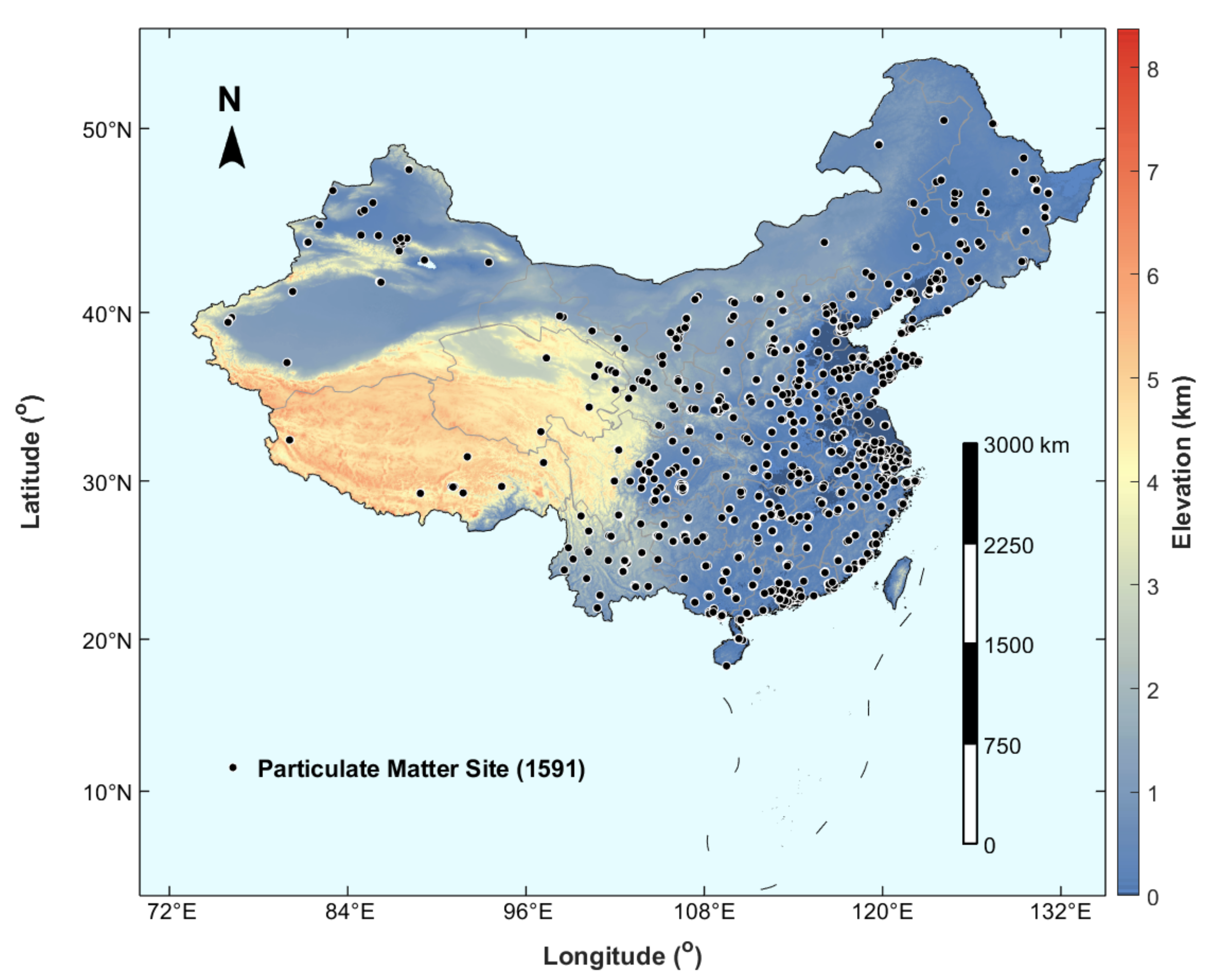
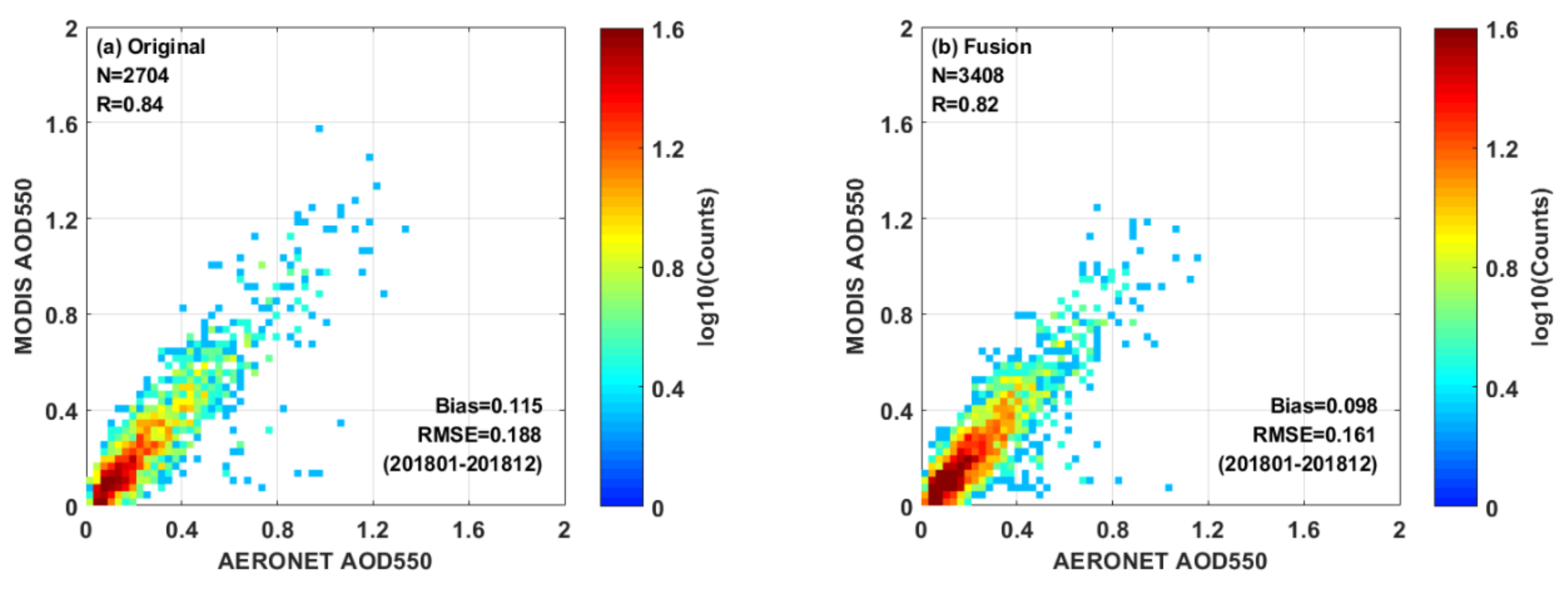
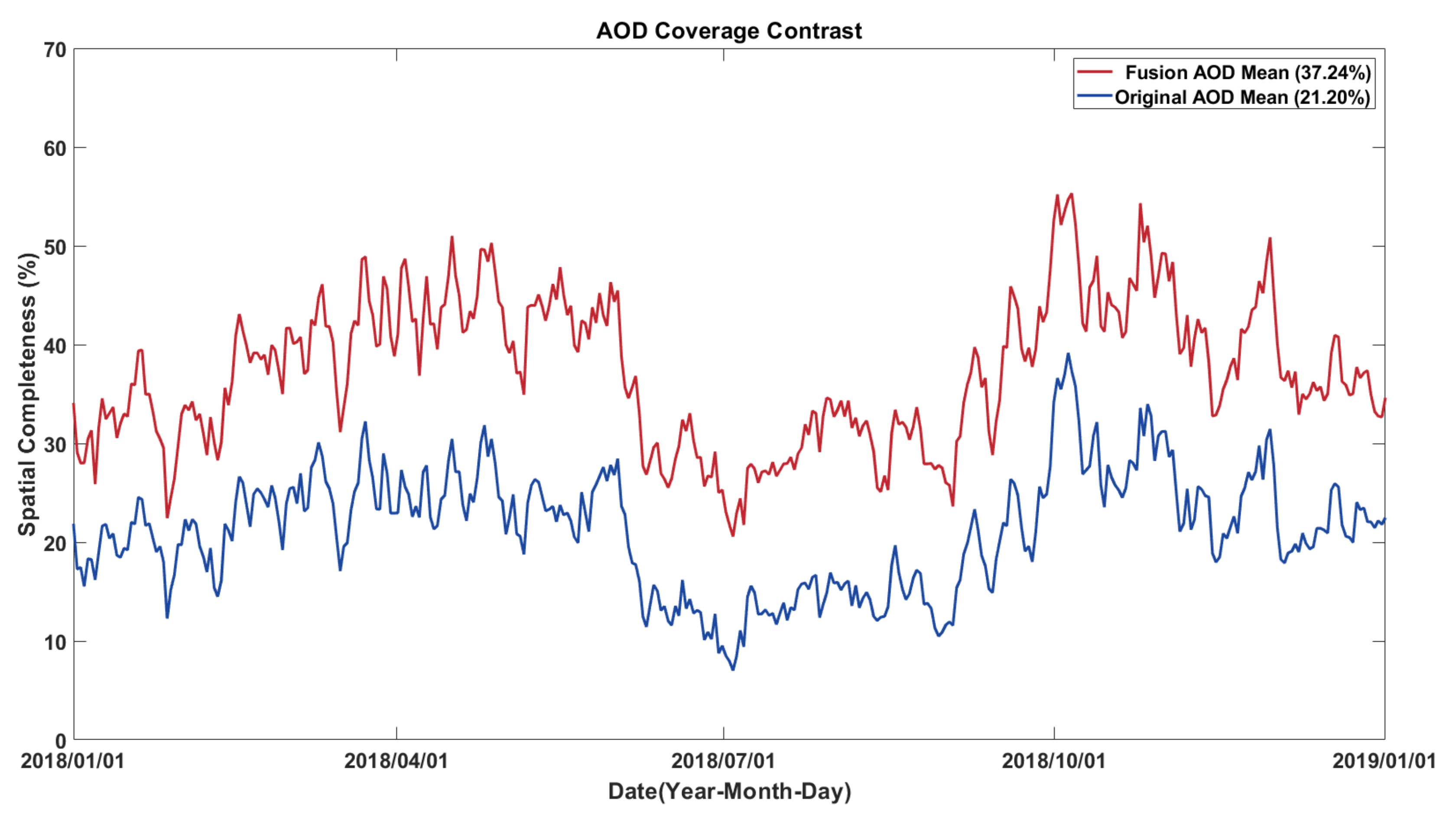
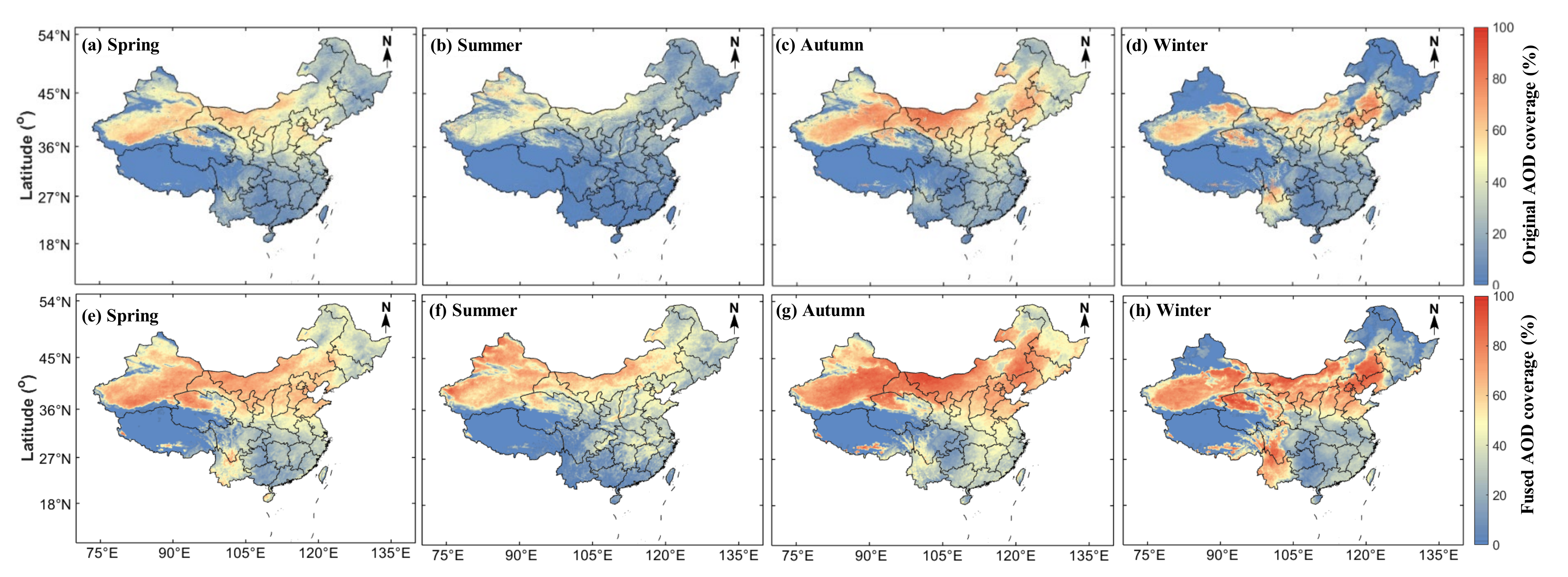
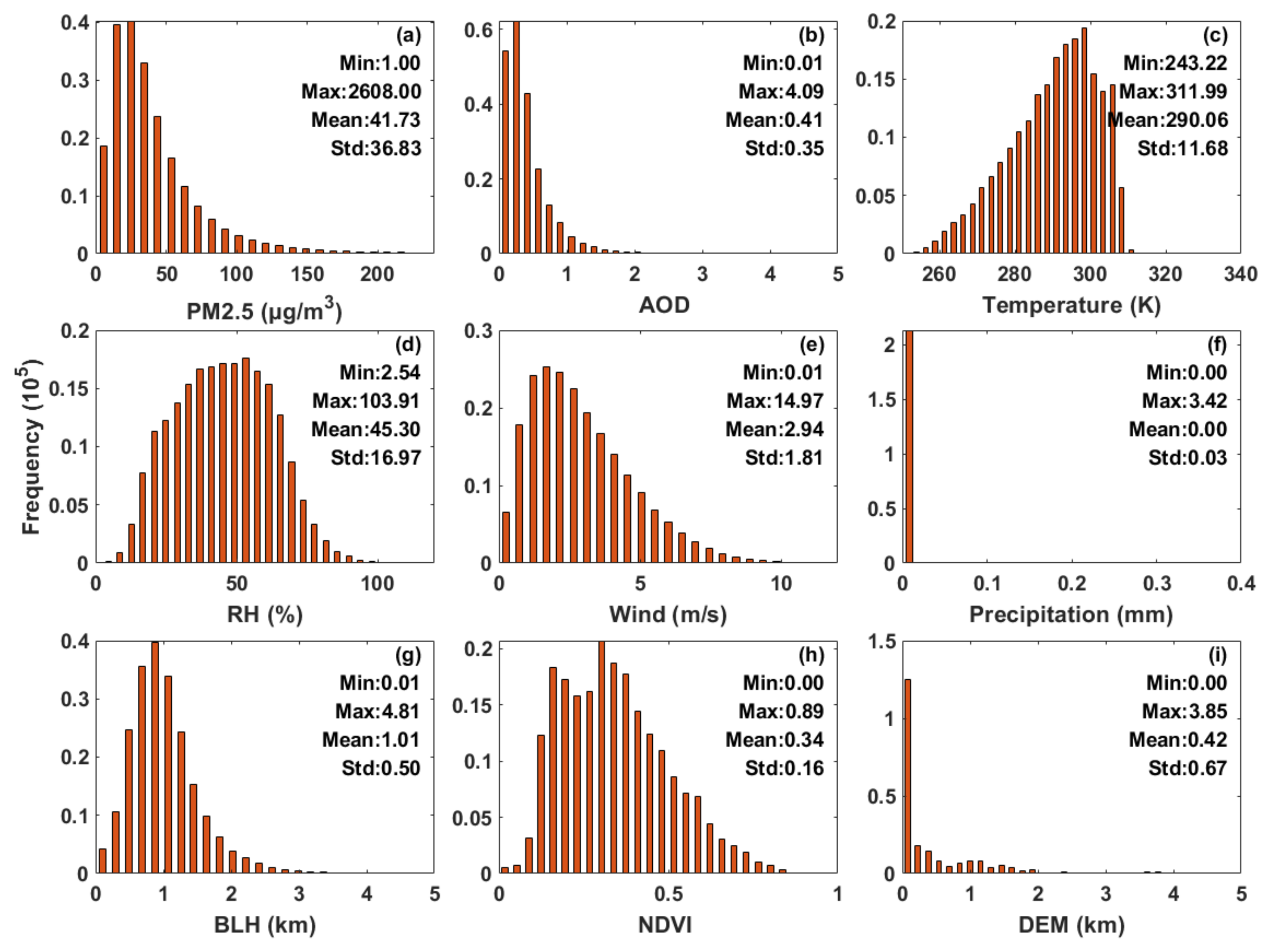
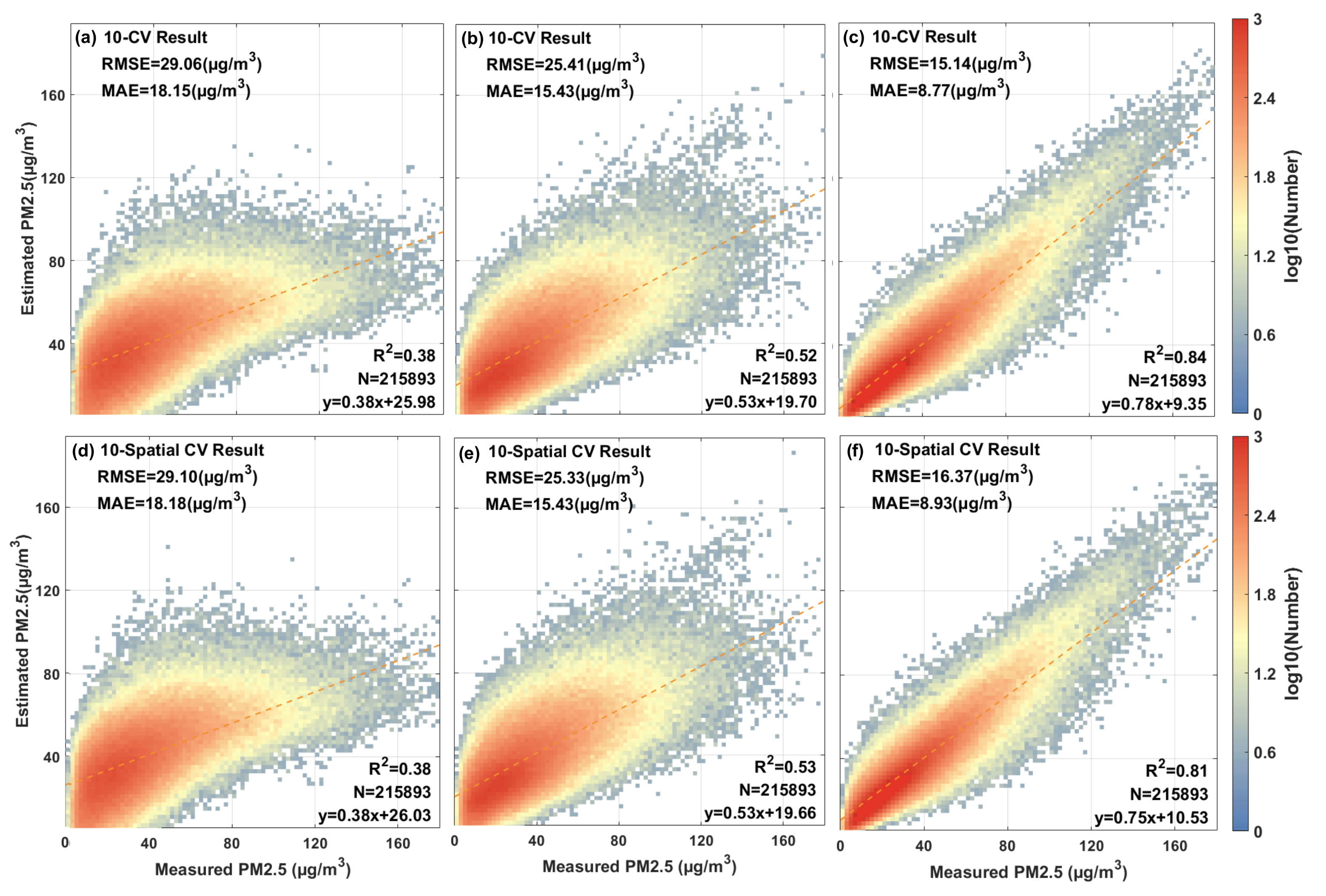
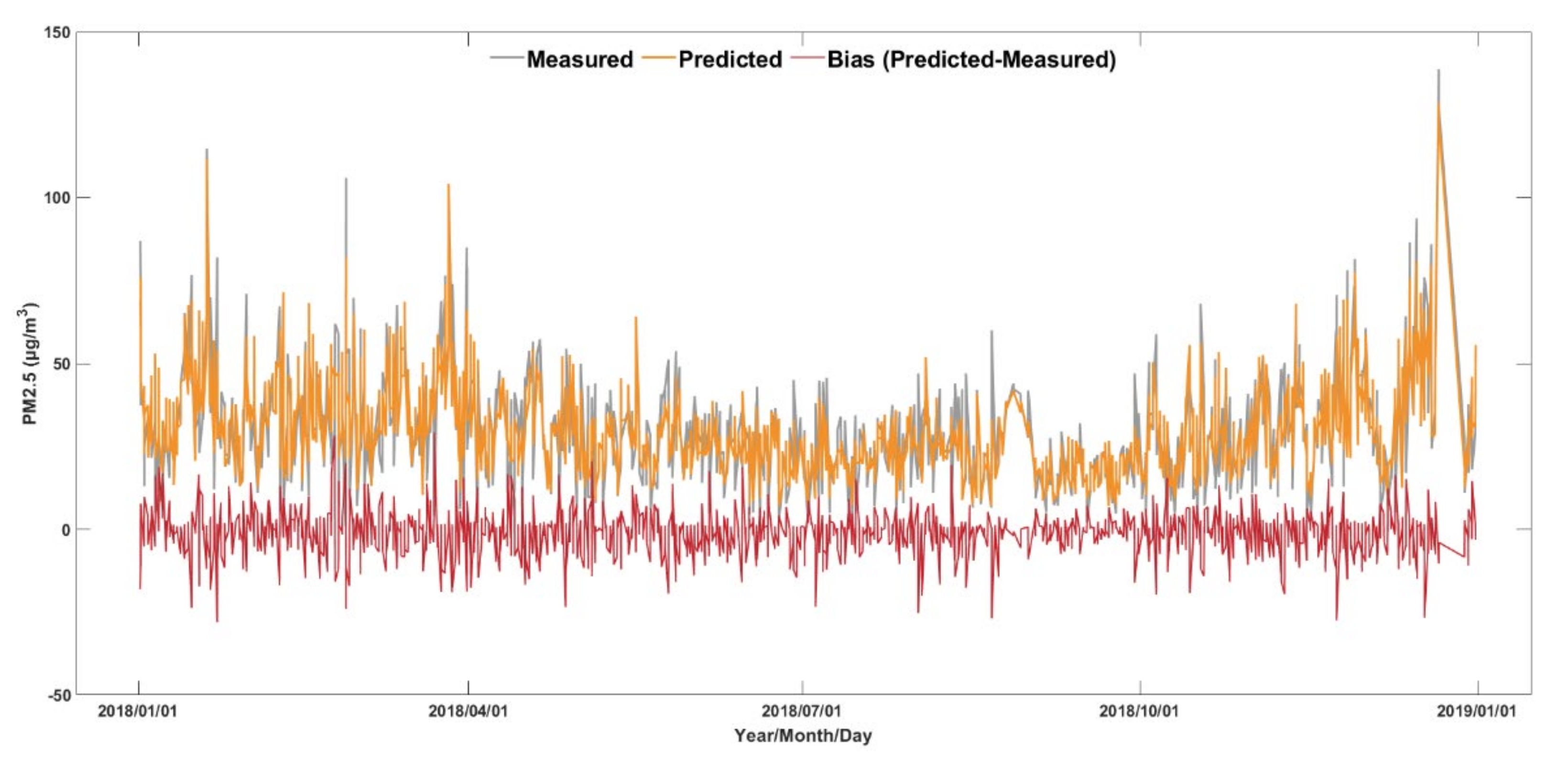
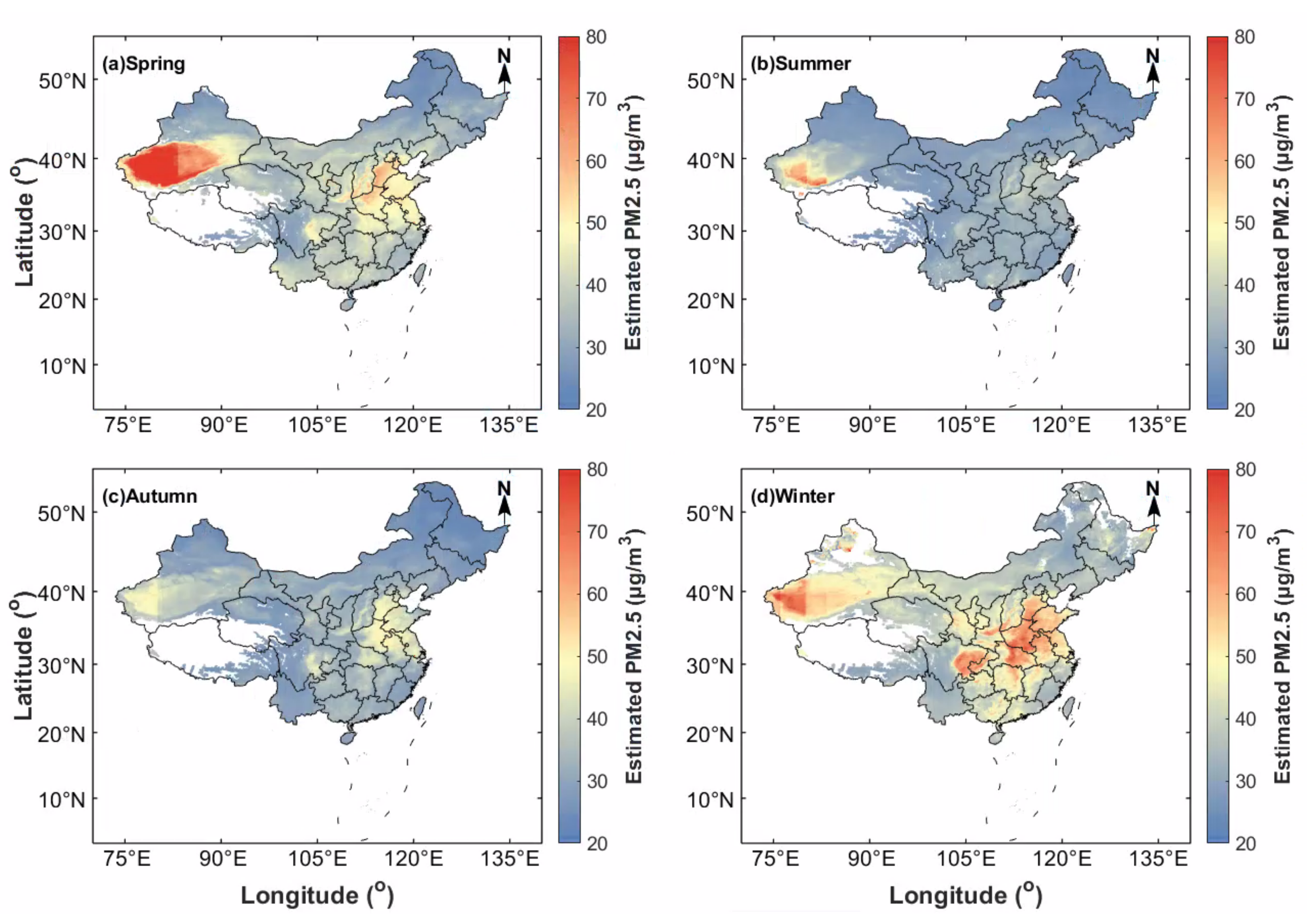
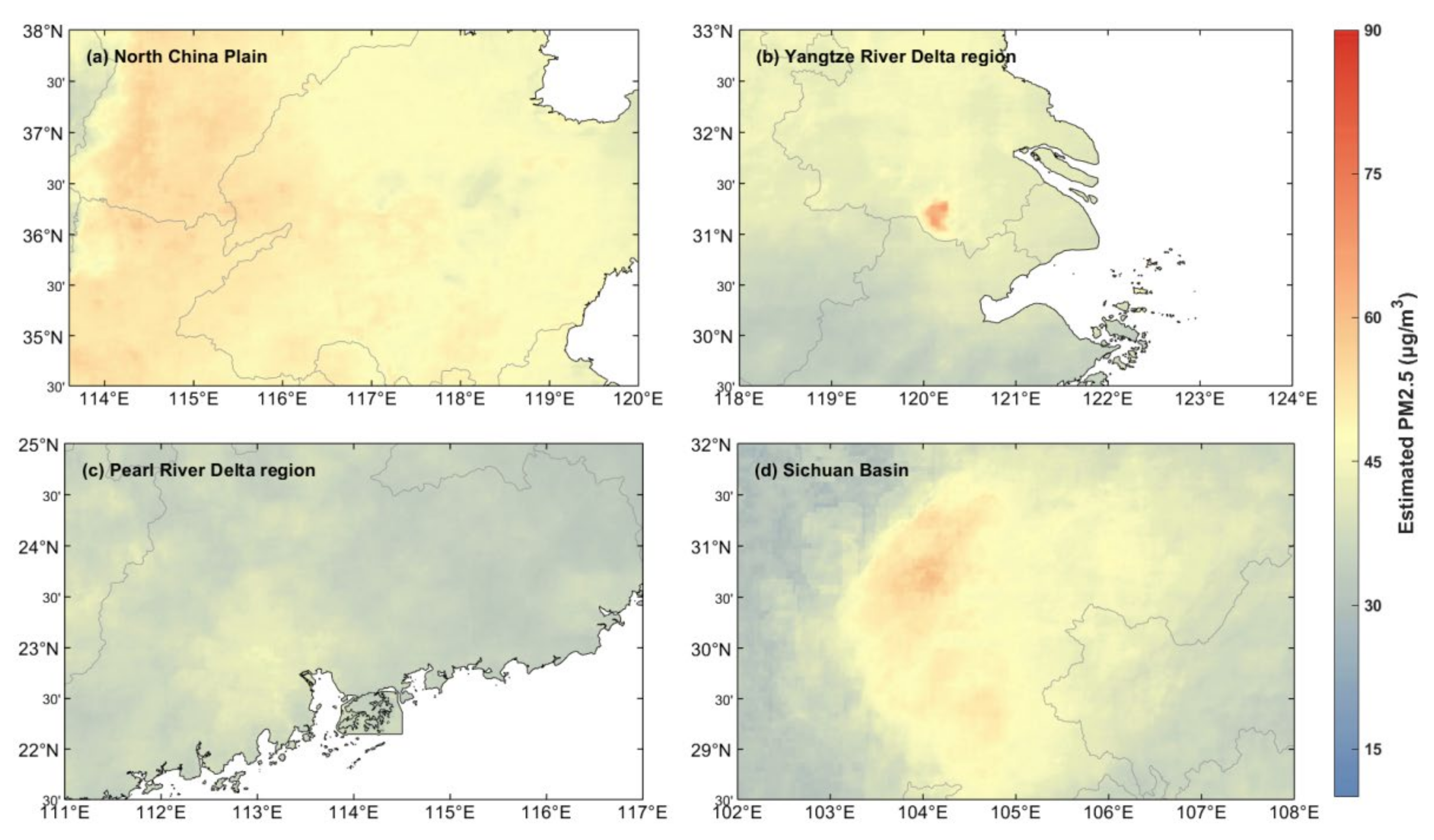
| Data | Variables | Unit | Temporal Resolution | Spatial Resolution | Sources |
|---|---|---|---|---|---|
| PM2.5 | PM2.5 | µg/m3 | 1 h | site | CNEMC |
| MAIAC AOD | AOD | Unitless | 1 day | 1 km | MODIS |
| VIIRS IP AOD | AOD | Unitless | 1 day | 750 m | S-NPP |
| Meteorological parameters | RH | % | 1 h | 0.25° | ERA5 |
| TEMP | K | 1 h | 0.25° | ||
| WS | m/s | 1 h | 0.25° | ||
| BLH | m | 1 h | 0.25° | ||
| Topographic factors | DEM | m | -- | 90 m | USGS |
| Vegetation factors | NDVI | Unitless | 16 days | 0.05° | MODIS |
Publisher’s Note: MDPI stays neutral with regard to jurisdictional claims in published maps and institutional affiliations. |
© 2021 by the authors. Licensee MDPI, Basel, Switzerland. This article is an open access article distributed under the terms and conditions of the Creative Commons Attribution (CC BY) license (https://creativecommons.org/licenses/by/4.0/).
Share and Cite
He, J.; Jin, Z.; Wang, W.; Zhang, Y. Mapping Seasonal High-Resolution PM2.5 Concentrations with Spatiotemporal Bagged-Tree Model across China. ISPRS Int. J. Geo-Inf. 2021, 10, 676. https://doi.org/10.3390/ijgi10100676
He J, Jin Z, Wang W, Zhang Y. Mapping Seasonal High-Resolution PM2.5 Concentrations with Spatiotemporal Bagged-Tree Model across China. ISPRS International Journal of Geo-Information. 2021; 10(10):676. https://doi.org/10.3390/ijgi10100676
Chicago/Turabian StyleHe, Junchen, Zhili Jin, Wei Wang, and Yixiao Zhang. 2021. "Mapping Seasonal High-Resolution PM2.5 Concentrations with Spatiotemporal Bagged-Tree Model across China" ISPRS International Journal of Geo-Information 10, no. 10: 676. https://doi.org/10.3390/ijgi10100676







